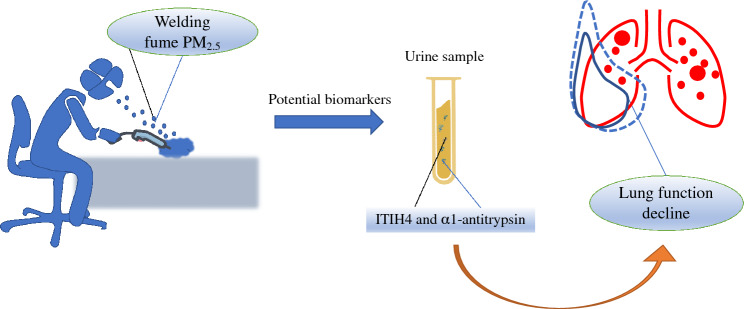- Record: found
- Abstract: found
- Article: found
Effects of occupational exposure to metal fume PM 2.5 on lung function and biomarkers among shipyard workers: a 3-year prospective cohort study

Read this article at
Abstract
Objective
This study investigates the associations of α1-antitrypsin, inter-α-trypsin inhibitor heavy chain (ITIH4), and 8-isoprostane with lung function in shipyard workers exposed to occupational metal fume fine particulate matter (PM 2.5), which is known to be associated with adverse respiratory outcomes.
Methods
A 3-year follow-up study was conducted on 180 shipyard workers with 262 measurements. Personal exposure to welding fume PM 2.5 was collected for an 8-h working day. Pre-exposure, post-exposure, and delta (∆) levels of α1-antitrypsin, ITIH4, and 8-isoprostane were determined in urine using enzyme-linked immunosorbent assays. Post-exposure urinary metals were sampled at the beginning of the next working day and analyzed by inductively coupled plasma-mass spectrometry. Lung function measurements were also conducted the next working day for post-exposure.
Results
An IQR increase in PM 2.5 was associated with decreases of 2.157% in FEV 1, 2.806% in PEF, 4.328% in FEF 25%, 5.047% in FEF 50%, and 7.205% in FEF 75%. An IQR increase in PM 2.5 led to increases of 42.155 µg/g in ∆α1-antitrypsin and 16.273 µg/g in ∆ITIH4. Notably, IQR increases in various urinary metals were associated with increases in specific biomarkers, such as post-urinary α1-antitrypsin and ITIH4. Moreover, increases in ∆ α1-antitrypsin and ∆ITIH4 were associated with decreases in FEV 1/FVC by 0.008% and 0.020%, respectively, and an increase in ∆8-isoprostane resulted in a 1.538% decline in FVC.
Related collections
Most cited references39
- Record: found
- Abstract: not found
- Article: not found
Standardisation of spirometry.
- Record: found
- Abstract: found
- Article: not found
Airborne particulate matter and human health: toxicological assessment and importance of size and composition of particles for oxidative damage and carcinogenic mechanisms.

- Record: found
- Abstract: found
- Article: found
